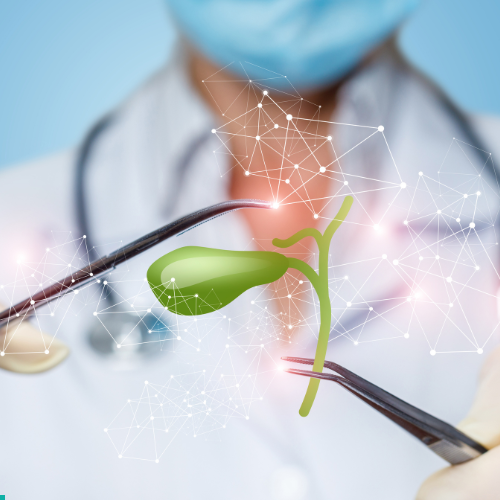Cholecystectomy
- Home
- Service

Cholecystectomy
Cholecystectomy
Overview
Cholecystectomy is a surgical procedure performed to remove the gallbladder, a small organ located beneath the liver. The gallbladder’s primary function is to store bile, a digestive fluid produced by the liver. Cholecystectomy is commonly performed to treat gallbladder-related conditions such as gallstones, inflammation of the gallbladder (cholecystitis), or gallbladder cancer.
The gallbladder is a pear-shaped organ located just below your liver on the upper right side of your abdomen. Cholecystectomy is a routine procedure with a low risk of complications. Often, patients can leave the hospital on the same day as their surgery.
There are two main approaches to this surgery: laparoscopic cholecystectomy and open cholecystectomy.
Indications for Cholecystectomy
The most common reason for performing a cholecystectomy is the presence of gallstones and the complications they cause. Your doctor may recommend this procedure if you have:
- Cholelithiasis (gallstones in the gallbladder)
- Bile duct gallstones (choledocholithiasis)
- Cholecystitis (inflammation of the gallbladder)
- Large polyps in the gallbladder
- Gallstones causing pancreatitis (inflammation of the pancreas)
Laparoscopic Cholecystectomy
Laparoscopic cholecystectomy is the most common and minimally invasive technique for removing the gallbladder. The procedure is performed under general anesthesia, and the surgeon makes several small incisions in the abdomen. Through these incisions, specialized surgical instruments and a laparoscope (a tiny camera) are inserted. The laparoscope provides a magnified view of the surgical area on a monitor, guiding the surgeon in performing the procedure accurately.
Carbon dioxide gas may be used to inflate the abdomen, creating more space for the surgeon to work. The surgeon then carefully detaches the gallbladder from its attachments to the liver and bile ducts. Afterward, the gallbladder is removed through one of the small incisions. The incisions are closed, and the patient is typically discharged on the same day or after a short hospital stay.
Open Cholecystectomy
Open cholecystectomy is the traditional approach used when laparoscopic surgery is not feasible or when a larger incision is needed for better access to the gallbladder. This procedure is also performed under general anesthesia, but a single, larger incision is made in the upper abdomen, usually just below the ribcage on the right side.
After the gallbladder is removed, the incision is closed with stitches or staples. The recovery time for open cholecystectomy is longer compared to laparoscopic cholecystectomy, and the patient may need a longer hospital stay.
Preparation for Cholecystectomy
Before the surgery, your healthcare team will perform several tests, such as:
- Belly ultrasound
- Blood tests
- Urine analysis (urine assessment)
The medical team will also discuss the following with you:
- Current medications you’re taking
- Options for pain management during and after surgery
- Fasting instructions prior to surgery
You will be given general anesthesia to ensure you are asleep and pain-free during the procedure. Once asleep, a tube will be inserted into your throat to assist with breathing. An IV line will be placed in your arm to provide fluids and medication.
Procedure Steps
A laparoscopic cholecystectomy typically lasts 1 to 2 hours. The surgeon will make several small incisions and insert thin, hollow tubes into them. Through these tubes, the surgical team will insert a laparoscope and other instruments. Carbon dioxide may be injected into your abdomen to improve visibility by inflating it. The surgeon will then use specialized tools to detach the gallbladder from the surrounding tissues and remove it.
If any complications arise during the laparoscopic procedure, the surgeon may switch to an open cholecystectomy, requiring a larger incision.
After the surgery, the healthcare team will monitor you to ensure you recover from the anesthesia without any issues. They will check your heart rate, breathing, blood pressure, and ability to urinate.
Benefits of Laparoscopic Cholecystectomy
Laparoscopic cholecystectomy is often recommended because it can alleviate the infection and pain caused by gallstones, and it helps prevent them from recurring. Untreated gallstones can cause severe discomfort and may even lead to gallbladder rupture, which can be fatal.
The majority of patients recover from laparoscopic cholecystectomy within a few weeks. However, if you experience any complications or have concerns following the surgery, it is important to contact your doctor.
